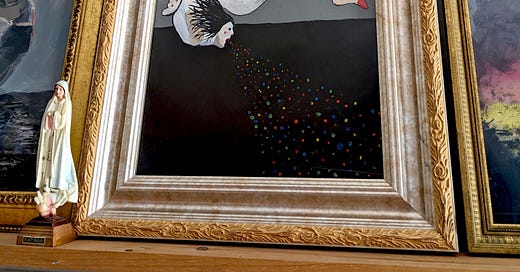The Power of Not-for-Sale Art
What if the piece you exhibit as not-for-sale turns out to be the most valuable? Here’s why I sometimes show NFS work—and how doing so has its benefits!
Recently, an art consultant shared a bold opinion on social media:
“It’s never a good idea to show NFS (Not for Sale) art in selling situations.”
His reasoning? People might “get jealous they can’t have it,” or assume “you’re keeping the best art for yourself.”
I see it differently.
Displaying a piece that’s not for sale can, in fact, serve an artist in several powerful and strategic ways —and I think it’s worth sharing why.

1. It Builds Visibility and Reputation
Even if the work isn’t for sale, exhibiting it gets your name in front of curators, collectors, galleries, and peers. It helps establish your voice, generate buzz, and open doors to new opportunities like collaborations, invitations, and press coverage.
Think about it: If you hadn’t included that one NFS piece in a group show, would you have been mentioned in the article covering the exhibition? Would that curator have asked you to be in their next show?
2. It Sparks Interest in Your Other Work
When a viewer connects with a piece—NFS or not—they’re more likely to seek out more of your work. That interest can drive traffic to your website or social media, prompt inquiries for commissions, and lead to sales of your available pieces. Sometimes, that “unavailable” piece is what draws them in.
3. It Adds Depth and Context to Your Practice
NFS works are often deeply personal, experimental, or pivotal in an artist’s development. Including them can offer a more complete, authentic view of your practice. It shows range, vulnerability, and intentionality—making your exhibition more memorable.
And sometimes, that’s the piece people can’t stop talking about. It creates a buzz that elevates your whole body of work.
4. It Creates Emotional or Conceptual Impact
Not-for-sale pieces often anchor a show, acting as emotional or thematic centerpieces. They can deliver a message that resonates deeply, encouraging conversation, reflection, and engagement. Why wouldn’t you want that?
5. It Attracts Curators and Institutions
Curators aren't only interested in what's for sale. They’re looking for substance, narrative, and meaning. Showing strong NFS work can catch their attention and lead to invitations for curated exhibitions, residencies, and grants. It signals that your work holds cultural or intellectual value—not just commercial appeal.
6. It Preserves Artistic Integrity
This, to me, is the most important reason.
Holding back a piece from sale can speak volumes about your values. It shows you’re not just making work to sell—you’re making it with purpose. That kind of integrity can earn the respect of collectors, critics, institutions, and peers. In some cases, it can open more doors than a sale ever could.
Final Thoughts
Are there downsides to showing NFS work? Maybe. But none of that outweigh the benefits outlined above.
Not everything has to be for sale to have value. In fact, your NFS piece might be the best ambassador for your practice. It’s not just about making a transaction—it’s about building a career.
There are many reasons a piece might be NFS: it’s already sold but on loan, it belongs to a private collector who prefers anonymity, it marks a milestone in your development, or it’s something you’re keeping for your personal archive. None of these are reasons not to show the work—especially if it represents your capabilities, your story, or the soul of what you do.
So, if you’ve been hesitant to exhibit a not-for-sale piece, consider this your permission slip.





I like the approach you took to this! Good points!